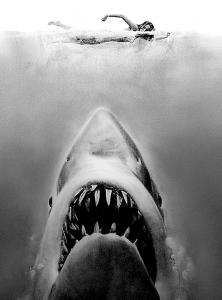What is hypochondria? And how should doctors treat people who suffer from excessive worrying about their health? The author of a book exploring this topic joins us on Chicago Tonight at 7:00 pm. Catherine Belling is the Assistant Professor of Medical Humanities & Bioethics at Northwestern University's Feinberg School of Medicine. Read an excerpt from her book: A Condition of Doubt: The Meanings of Hypochondria.
I originally meant to call this book “Swimming in the Dark.” In thinking about the hypochondriacal experience of embodiment as anxious and dangerous, I kept returning to a powerful popular image that is only figuratively a representation of the body’s interior but is very literally about swimming in the dark. This is the poster for the film Jaws, closely based on the cover illustration for Peter Benchley’s novel of the same name. It is an image that came to stand for mid-1970s cultural anxiety as mass-marketing phenomenon, a clear and graphic way to represent uncertainty in the aftermath of massive sociocultural (and, as we have seen, clinical and bioethical) change.
Depicting a woman suspended in water, apparently unaware of a giant shark rising toward her, the poster gives us not only an image of danger but also, I think, a spatial-visual metaphor for the experience of embodiment. Imagine the water’s surface as skin, a membrane both separating and connecting water and air, the body’s inside and its outside. We look outward, upward from our bodies, from inside them, yet the inside we are in is largely invisible to us, the surface opaque. To visualize (imagine visually, that is, which is not the same as to see) what is down there, we must read sensations as symptoms. The subject or mind seems suspended in the body like the swimming woman in the ocean. Read figuratively, then, the poster is a psychosomatic kind of image, both of a patient, the woman a Cartesian self, at sea in her body, and of the patient’s body as it exists in her mind, an image of self (itself, recursively, in a body of its own) suspended in an opaque medium over an abyss where monsters lurk. Worse still, the woman is exposed to a terrible threat that we, in our impossibly omniscient viewing position, can see—but to which she is oblivious. We may fear more because of her ignorance, which forces us to try and imagine the impending dangers of which we are, presently and temporarily, ignorant. Her apparent complacency becomes a warning to the viewer. What is lurking beneath your surface right now?
Some years ago, working on a talk about the fear of disease, I tested my metaphorical reading of the Jaws poster. I said I thought it might capture the way it feels to be waiting for, say, a biopsy result. Several audience members approached me afterward to say that the image rang true to their own experiences. One person told me that it captured precisely how she had felt recently as she awaited a possible cancer diagnosis, intolerably unsure about the possible presence of the monster that might kill her and which, despite the uncertainty, she could not help imagining, repeatedly, in all sorts of horrible detail. Notice that such a viewer, in imagining herself in danger as the swimmer is, simultaneously stops identifying with the swimmer, who appears not to consider herself in danger. Note, too, that such a viewer does not know there is a shark beneath her, or a malignant tumor in her body. The image’s potency comes from the fact that the danger is imagined—which need not mean that it not also (still invisibly) present.
To make the medical meaning of this suspense more explicit in my talk, I had juxtaposed the Jaws poster with a chest X-ray containing a looming white shadow that may—or may not—be a tumor. The chest X-ray seems different from the poster in that, we assume, the patient must be aware of the ominous, asymmetrical, shark-like white mass. This is not necessarily the case. The patient is not the first reader of such an image, and the patient is not trained to read it; she cannot tell what a white mark might represent. This image, like that of the images. But I am saying that certainty is impossible, and that in the absence of certainty, of seeing the thing itself, some of us, or maybe all of us sometimes, see the full story entailed in the still image, see the woman eaten, the cancer metastasized, the patient dead. This projection of plot onto the single image is also the kind of body reading that underlies hypochondria, endowing signs and symptoms with meaning in the context of received, and therefore expected, disease narratives.
The image publicizing Jaws is a hypochondriacal one in two ways, then: it carries its own worst-case scenario as a necessary part of its meaning, and it also provokes that expectation outside the frame of the text itself. An image like this one, then, actively provokes anxiety—and if we read the woman as suspended in a figurative rather than a literal ocean, in the opaque medium of her own body, it provokes hypochondria, which posits both danger lurking in the body and an urgent need to expose that danger, no matter how painful its discovery might be. The hypochondriac expects medicine to show us the shark, to render the body transparent as a glass aquarium or a specimen jar.
Excerpt from Catherine Belling, A Condition of Doubt (Oxford University Press, 2012)




